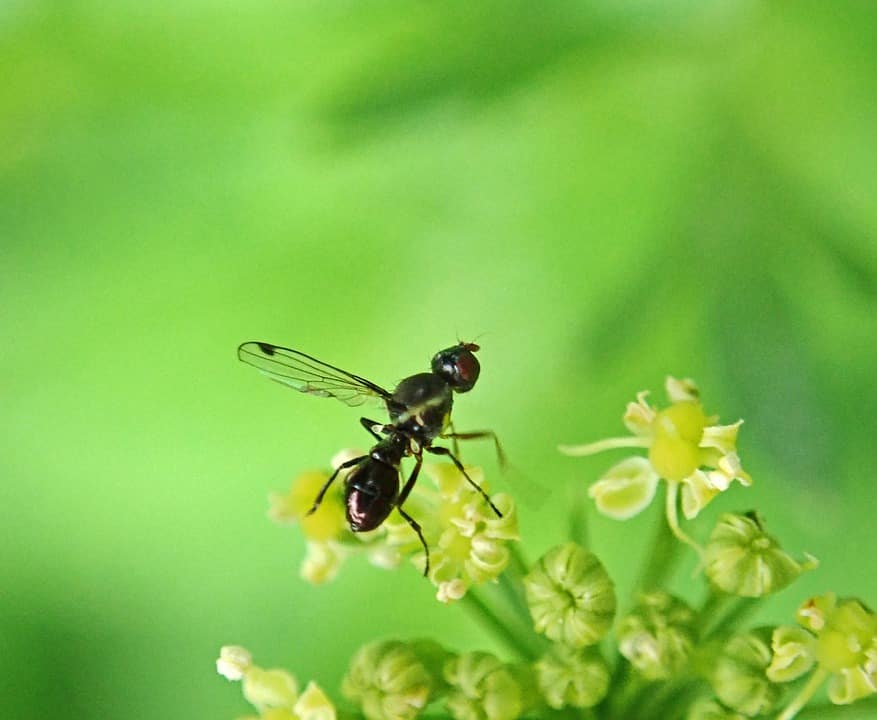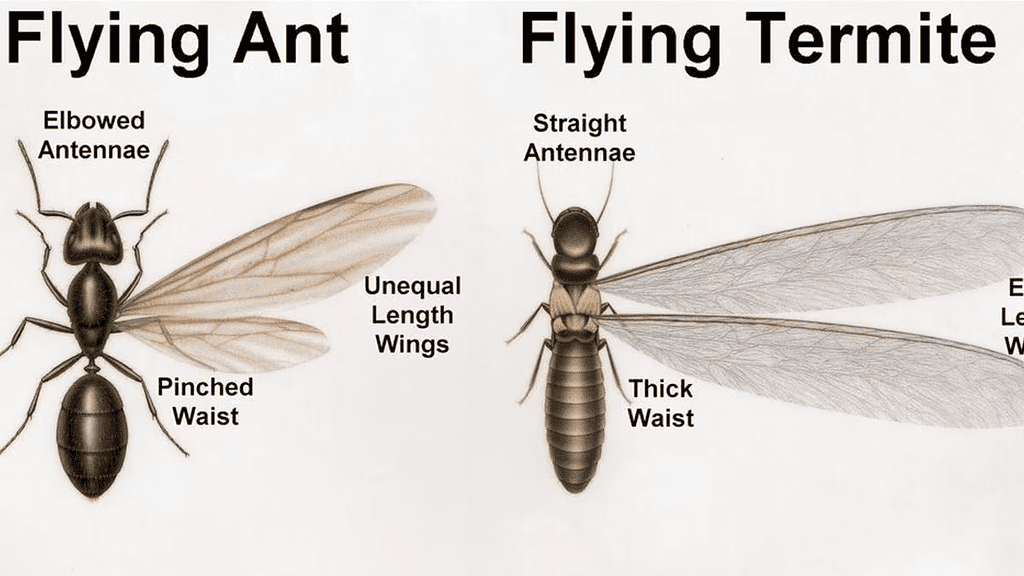
In 2018, a decisive second-round match at Wimbledon, between two tennis heavyweights was halted after a seemingly biblical swarm of insects invaded the pitch. Specifically, it was ants with wings. It wasn’t a sign of the end of times. Instead, it was just a particularly funny case of animal behavior, specifically myrmecology.
What ants have wings and why?
Ants are some of the most widely distributed animals all over the world. Bar Antarctica, they’re found everywhere. We’re accustomed to watching these little critters dash across the ground in their typical neat and orderly lines. So, it is weird when, seemingly out of nowhere, we encounter shockingly large ants flying all over the place – especially in the springtime.
It’s also particularly jarring that they only seem to take to the sky in colossal swarms of hundreds or even thousands of individuals. But you need not worry.
It’s tempting just to rub our eyes and dismiss these swarms as wasps or termites. Don’t worry as you don’t have to convince yourself otherwise because yes, flying ants (called alates) do exist. In fact, they’re a lot more prevalent than we realize.
Ants fly to mate. Unlike worker ants, they can reproduce. However, not all species of ants have wings and can fly. Currently, scientists have identified 12,000 distinct species of ants all over the world. Of these 12,000, a majority of ant species do indeed mate in flight yet a select few mate on the ground, by budding. In this process, the queen ant just leads reproductive males out of the nest, to a secondary location at which she plans to pitch her new colony.

Only virgin ants have wings
Ants, like bees and wasps, are social animals. Social insects such as ants and bees form colonies, nests, or hives that house anywhere between just a dozen or so individuals or even up to a million individuals.
Like any social species with more than a handful of individuals, these colonies or nests are based on a strict chain of command. A typical ant colony consists of three ranks of ants.
Whether it’s a series of interlinked underground tunnels or a delicate tapestry of woven leaves high up in the canopy, queen ants make up the heart of each ant colony. Literally. In many single-queen species, like leafcutter ants, a queen’s death also marks the colony’s death. A few species, like carpenter ants or pharaoh ants, break this convention.
Carpenter ants can have multiple queen ants at once. This is an evolutionary cheat code that gives the colony an edge, to persist beyond the lifespan of just one queen. It’s also why, if you see an ant with wings, there’s a good chance it’s a carpenter ant.
The second-ranked members of the colony, the worker ants, make up the (you guessed it) workforce of the colony. Worker ants are female ants that service the queen. They are sterile and nurse the queen’s offspring. They’re also called forager ants as their primary duties include foraging for food. Despite being female, worker ants can’t reproduce and can’t lay eggs.
Finally, we have the drones. Drones are male ants. They live and die by just one notion: sex. They live for just under two days within which they hatch, sexually mature, mate with the queen, and then promptly die. So, in a colony of ants, only two of the three ranks of ants can actually fly. These are queens and drones.
Winged ants are seeking to breed and reproduce

Queens are typically much larger than drones and have larger wings as well.
Still, drones and queens actually can’t fly whenever they want to. Queen ants don’t have wings all year round. Most ant species only mate once a year, usually sometime between spring and fall. It is only during this mating season that virgin queens grow their wings. Similarly, drones only hatch during mating season as well.
So if you see an ant with wings, it’s a virgin looking to reproduce. This kind of makes it a bit less scary, doesn’t it?
Although the exact time and date differ for each species, most species of ants perform a nuptial flight to facilitate their mating seasons. In a nuptial flight, the queens and the drones take to the skies. Drones don’t wait their turn either. To better ensure their safety, they swarm the queen in numbers. To the uninitiated observer, this swarming behavior may look threatening but don’t worry, these ants just have one thing on their mind.
In several countries, flying ants are a celebrated nuisance. Every year, sometime between June and August, many species of ants seemingly decide to mate all at once.
The dreaded day is aptly named “Flying Ant Day” however flying ant day doesn’t actually mark the end of mating season. It’s just a particular day of the season when mating activity peaks. The actual mating season lasts for around four months, from June to September.
Termites with wings

Termites have a lot in common with ants. They’re both social animals that live in supersized colonies. Similar to ants, termites also sprout wings during their reproductive season. Only the queen termites and the drones develop wings and take part in the nuptial flight. So yes, you may also see a termite with wings.
As both termites and ants fly to establish new colonies, it is important to know how to tell the two apart to prevent serious property damage properly. There are a couple of helpful tips to keep in mind when trying to distinguish between the two. For instance, an easy way to tell termites from ants is to look at either their antennae or wings.
Ants have bent antennae while termites generally have bent ones. Likewise, ants also have two pairs of differently-sized wings whereas termites have two pairs of identical wings.
Are flying ants dangerous?
Not in the slightest. Although the swarms look dangerous, an attack is the last thing on their mind. Ants only fly to mate. Male ants almost always immediately die after mating. Usually, they don’t even enter their nests again.
If they do make it back to the nests, the workers drive them right back out with a vengeance. Queens, on the other hand, lose their wings, but not their lives. Once, queens are done with the nuptial flight, they then set out to colonize new lands.
So if you see an ant with wings coming at you (or even several), don’t worry. There’s nothing really bad that could happen to you.
Facts about winged ants
Although we get jittery when any terrestrial insect suddenly takes to the sky, when it comes to flying ants, we can rest easy knowing that they pose absolutely no threat to humans. In fact, flying ants are the opposite of threats.
For instance, the only thing flying ants eat is themselves. Post the nuptial flight, the queen ant, happy and satiated with her fresh haul of sperm, lands on the spot of her new colony. Here, she proceeds to chew her own wings off.
As males die soon after mating, they’re easy prey. Other insects like dragonflies and butterflies as well as larger predators like insectivorous birds can easily hunt down individual males after the conclusion of the nuptial flight.
Here are a few other interesting facts about winged ants:
- Ants are insects that form complex societies. They divide labor and function. If an ant colony has winged ants, it’s likely a sign that the colony is mature and in good health.
- The wings are temporary. They’re only used for mating and then discarded, in a rather gruesome fashion.
- Ants can mate during the flight.
- Winged males have no other purpose than breeding. In fact, as one researcher put it, they are “single-purpose sexual missiles.”
- It’s sometimes said that winged ants are attracted to light, but the evidence to support this is rather thin.
- Different colonies from the same species synchronize the release of the winged males and queens. They do this by using the same environmental cues. This is useful to avoid interbreeding and mate with ants from other nests.
- A queen typically makes with several males, storing their sperm in a special organ.
- Not all ants follow this pattern described above. In army ants, for instance, only males have wings.
- On some days, there are so many flying ants they can be picked up by radar systems. This often attracts predators like birds looking to munch on the flying ants.
So there you have it, there’s nothing to fear. Ants with wings are not an oddity, they’re one of the ways evolution managed to navigate reproduction.


